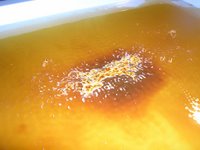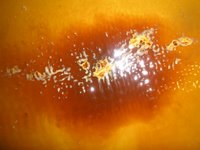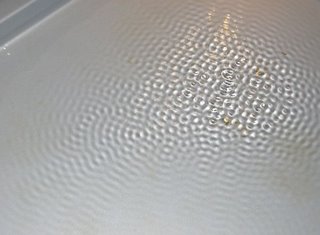
This morning I attended a student (Olaf Hochherz) examination for the electro-acoustics and sound design. The project consisted of sound design for a film studies student - a film documenting a cat colony in a Rome cemetery. The interesting thing about Olaf's sound design was the fact that he had nothing to really work with - just ambient soundscapes, discreet diabetic sound and the occasional interview. Despite this, it sounded excellent, with a suitable spatialisation and very nice distribution of sound. The mix was designed for a 6.1 speaker set-up, with three up front (left, centre, right), two in the back and two in the extreme back angled at 60 degrees towards the ceiling.
In the afternoon Lauren and I headed down to the echo viaduct Robin and Susan had shown us a couple of days ago. I've thrown together some video documentation, I'll do some decent recordings over the next couple of days.
It's also really nice to see a little blue sky and sun after three days of gloom and rain.
September 25, 2008
Day 10: Sounding out Weimar
January 23, 2007
[21.1.07] Making Sound Work: Sound art workshop
On the weekend I checked out Jason Sweeney's "Making Sound Work" sound art workshop at Headquarters Studio in Richmond, invited by Jason to drop by and talk about sound art and myself for a bit.
The workshop attracted just under a dozen participants from broad artistic backgrounds, including two guys who came all the way from Melbourne for the event! The workshop kicked off on Saturday, and I dropped by on Sunday afternoon to see how things were coming along. The sessions involved participants creating works (as individuals or small groups) with whatever materials were around, this included vintage synths, guitars, tape machines, record players, samplers, effects pedals and microphones. The works performed were more or less improvised, with a compositional and performative structure worked out beforehand (which included loose instructions by Jason.) The results were varied though mostly enjoyable with plenty of creativity, spontaneity and invention from the participants. In fact, some of the best works I heard were from the participants who were either unfamiliar or had some trepidation about using a particular instrument or device. As a result, there was refreshingly little ego in sight.
I talked briefly about how sound art is regarded as an artistic practice, giving examples of my own work as well as commenting on some the performances I had heard that afternoon. I mentioned that the predominant nature of the works (which were conceptual and process driven) had a strong tie to the aesthetic of sound art, and how the absence of a formal language (i.e. musical) dictated the works in terms of being inter-mediatory, spontaneous and in some cases, specific to particular space or object. I also mentioned how pleasing it was to not see a single laptop in sight!
I did contribute one work later in the afternoon - walking very slowly from one end of the gallery space to the other using an egg-shaker to articulate the resonances of each room.
Jason's Website
Here are some pictures I took:






January 16, 2007
[16.1.07] BEAP 07 Abstract Submission - Feedback appreciated
Since leaving my post at Adelaide University as a failed post-graduate, I've been struggling to regain some confidence in my writing. Therefore, with the Bienniale of Electronic Art in Perth (BEAP) coming up in Setember this year, I thought I would submit an abstract on the CADE conference theme of 'stillness'. My abstract is a point of departure for examining sound and stillness, titled: 'Auditory Stillness as Phenomena.'
My writing skills are still rusty as you may notice, and hopefully it all doesn't seem too convoluted.
It can be read here, any feedback would be kindly appreciated.
September 08, 2006
[8.9.07] Water, Materials & Sound (II)
1. Water, paper, instant coffee.
A piece of paper is immersed in a very shallow amount of water, as the metal surface vibrates and makes the sound waves visible on the surface of the water, grains of instant coffee are dropped in the centre of the paper. A low sine wave frequency of 65.4 Hz (i.e C2) was used to resonate the surface of the tray, only a small amount of volume was required to make the waves visible.

As you can see by the image (above), it is a little hard to tell whether the sound waves are affecting the movement of the dissolving coffee grains. Paper was used with the intention of allowing the coffee to stain its surface, in effect 'imprinting' sound and giving it some kind of permanence.
2. Water, instant coffee.
Similar method, though no paper used this time, just the shallow water and the coffee grains. The same sine wave frequency of 65.4 Hz was used.
Again, difficult do really determine the waves influence of the dissolving coffee grains, but visually it was quite interesting.




3. Water, ground nutmeg.
Finally, some success. Nutmeg grains were immersed in the shallow water, and one the had settled on the surface of the tray, the C2 tone was played and left for one hour. The images below show the formation state in ten minute intervals. To observe the details of the process I uggest you click on the image below to enlarge it. (don't panic it's 'websafe')

I would say that my experiments in this field have been exhausted for the time being. I will revisit them when I can find a means of applying them in an appropriate installation and/or performance context.
August 29, 2006
[29.08.06] Visualising sound with water and light

With the setup of speaker, water tray and directional light (amp and oscillator out of shot.) What I'm doing here is trying to move the waves around manually.

Example one: A low frequency resonance (note large bandwidth). The metal tray has many resonant nodes, the complicated formation is due to the waves reflecting off the edges and corners. It would be interesting to see a more pure representation of a single spherical formation - though this is proving difficult to acheive.

Example 2: A much more elaborate formation at a higher frequency with a shallower amount of water. A blue bulb was being used at the stage.
